Stock Set Up: Difference between revisions
Lwinchester (talk | contribs) |
Lwinchester (talk | contribs) |
||
| Line 234: | Line 234: | ||
P - Production Date <br/> | P - Production Date <br/> | ||
T - Tea Garden Invoice <br/> | T - Tea Garden Invoice <br/> | ||
N - No Rotation '''Note:''' lot traceability cannot be changed where there is on hand stock for the product||G | N - No Rotation <br/> '''Note:''' lot traceability cannot be changed where there is on hand stock for the product||G | ||
|- | |- | ||
|Allocation Sequence ** || Allows the user to specify in what priority order allocation will take place for this product|| | |Allocation Sequence ** || Allows the user to specify in what priority order allocation will take place for this product|| | ||
Revision as of 11:33, 3 September 2010
INTRODUCTION
This page describes the required screens to be used in setting up the information concerned with the stock to be stored in the warehouse. Other guides describe the set up of company, user, warehouse, owners etc.
This is a generic guide based on the version of the system at the time of writing.
It can also be used by clients to specify their specific data values to aid initial system set up as well as for future reference.
Note that fields marked ‘**’ are mandatory and are needed to ensure correct set up of the system.
OVERVIEW
The configuration dependency diagram below illustrates which configuration levels are contingent upon preceding configuration. The pre-requisites for setting up stock information are:
1. Product type
2. Product class
3. Unit of measure
The main stock information is input in a number of tab screens within the main screen. Note that it is necessary to input all mandatory fields on all tabs before a product can be used within the system.
Once stock information is available it is possible to define:
1. Substitute stock
2. Sales kit configuration
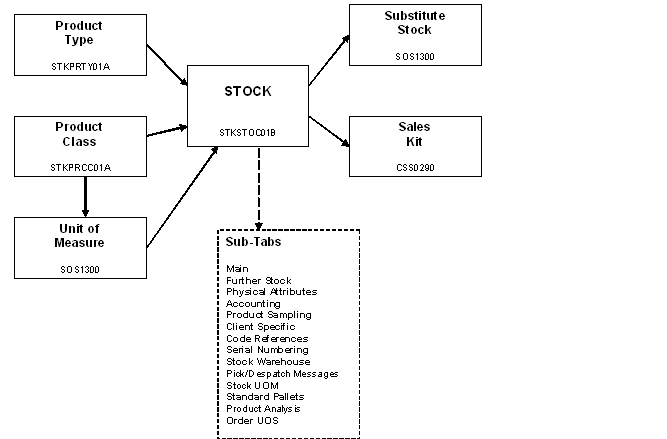
PRODUCT TYPE MAINTENANCE (STKPRTY01A)
Product type configuration is a pre-requisite to the configuration of products, given that product type is a mandatory field in the product configuration. Product types enable the grouping of stock, usually by physical classification. For example, frozen, chilled or ambient products may each be assigned a distinct product type, this will have an inpact on how orders are processed and displayed in the system.
Note
If an order is made up of multiple product types, the system will allow individual allocation and picking by product type, in effect splitting the pick list.
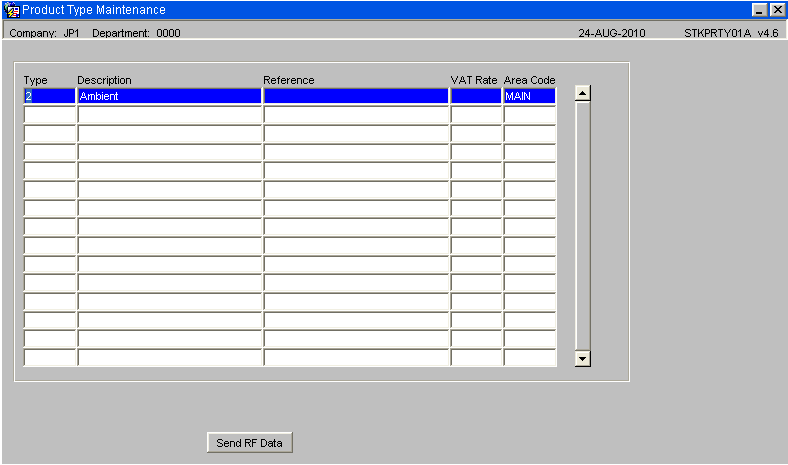
NB: If RF is enabled there will be the option to send the entire table to the WCS. All amended or newly created records are automatically sent to the WCS on update of the record.
| Field Name | Description | Options | Generic Values |
|---|---|---|---|
| Type | Specifies a particular product type. Product type differentiation enables separation of sales order processing via pick wave building. | 1 character free text field | Defined by the client |
| Decription | Describes the product type as above | 30 character free text field or left blank | Defined by the client |
| Reference | Used with Owner Charging and Invoicing | 30 character free text field or left blank | Defined by the client |
| VAT Rate | Used with Owner Charging and Invoicing | 30 character free text field or left blank | Defined by the client |
| Area Code | Used with putaway and also a selection parameter within Pick Wave Maintenance | LOV of valid Area Codes | Defined by the client |
PRODUCT CLASS MAINTENANCE (STKPRCC01A)
Product Range, Class, Category and Group combinations are created in order to segregate stock within the warehouse. They can also be used to distinguish one type of product from another. You can use these combinations to specify putaway routines and for stocktaking purposes. Note, although you see all four here, when you set them up you have to create the range first, go through the rest of the fields and save the record. When you come to create the class field, you have to enter the range you just created and then go through the same process. In this way, you can have multiple combinations of all four criteria.
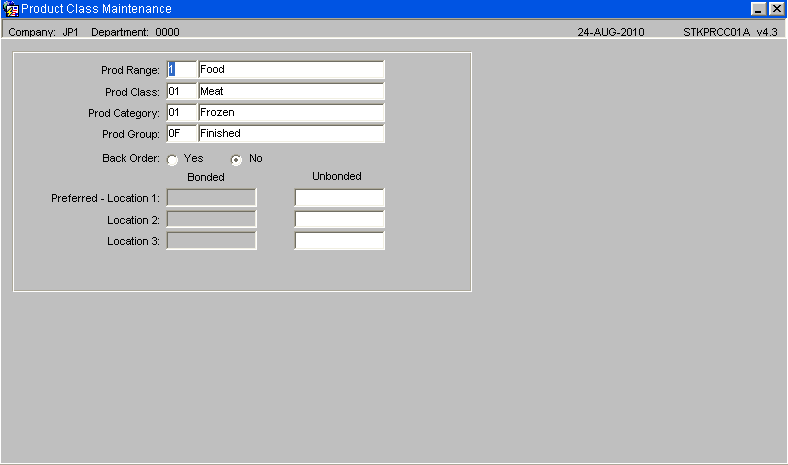
| Field Name | Description | Options | Generic Values |
|---|---|---|---|
| Prod Range ** | Used to denote a specific range for multiple products in conjunction with class, category and group | 1 character free text field | Defined by the client |
| Prod Class ** | Used to denote a specific class for multiple products in conjunction with range, category and group | 2 character free text field | Defined by the client |
| Prod Category ** | Used to denote a specific category for multiple products in conjunction with range, class and group | 2 character free text field | Defined by the client |
| Prod Group ** | Used to denote a specific group for multiple products | 2 character free text field | Defined by the client |
| Back Order ** | Used in union with other flags throughout the system to determine whether back ordering will be utilised Y or N | Defaults to No | N - Functionality not yet migrated |
| Preferred Location Unbonded | Specifies putaway anchor points for the range,class,category,group combination | Must be valid locations or left blank – LOV available | Defined by the client |
UNIT OF MEASURE MAINTENANCE (SOS1300)
Unit of measure maintenance, enables the configuration of warehouse storage medium for specific product groups, this level of configuration is a pre-requisite for the configuration of individual products, in that the UOMs configured against a product group will be applied to the stock codes that are assigned that product grouping.
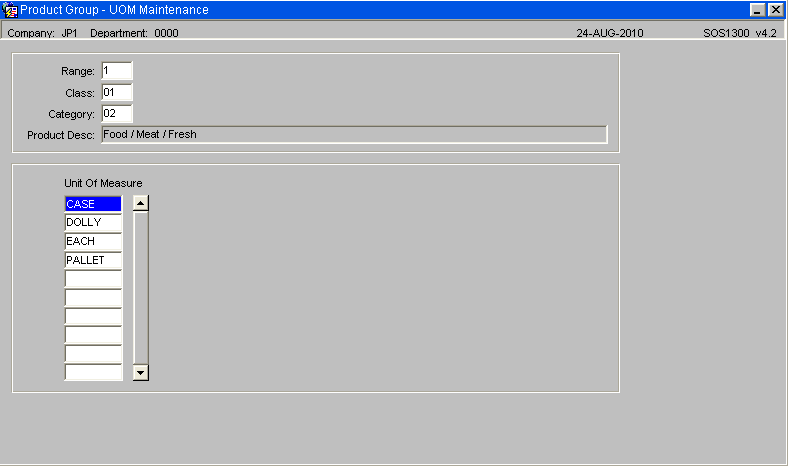
| Field Name | Description | Options | Generic Values |
|---|---|---|---|
| Range, Class, Category ** | No entry allowed, the screen comes in as query mode and you find the combination of range, class, category you wish to assign valid unit of measures to. | Must already have been created in product class maintenance – LOV available | Defined by the client |
| Unit of Measure ** | Used to define what media the products will be packaged in/stored on. This will be used later in processing to determine how goods will be received into/ despatched from the warehouse. | 6 character free text field | Defined by the client |
STOCK MAINTENANCE (STKSTOC01B
This form and all the tabbed sub screens carry all the product level configuration settings.
Stock Maintenance – Main Tab
First group of general product details.
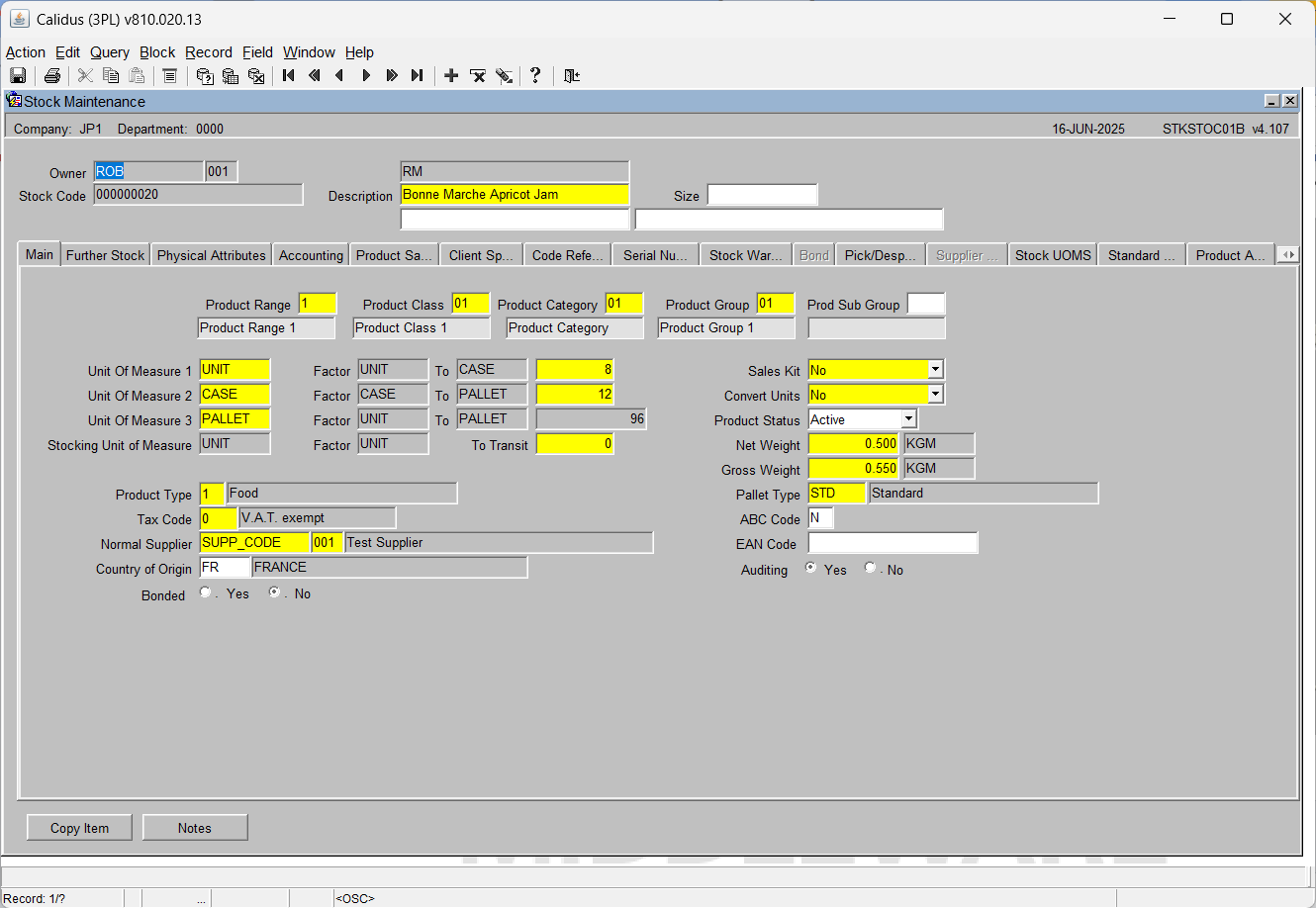
| Field Name | Description | Options | Generic Value |
| Owner ** | Owner code the product is to be created against (the description will default to that setup in owner maintenance) | Must have been created in owner maintenance and be assigned to the current login id (will default to common) – LOV available | Defined by the client |
| Stock code ** | The product code you will be creating | 20 character free text field | Defined by the client |
| Description ** | The description of the product you are creating. This description will appear on pick lists and receipt notes etc | 30 character free text field | Defined by the client |
| Description 2 | An additional description for the product | 30 character free text field or left blank | Blank |
| Description 3 | An additional description for the product | 30 character free text field or left blank | Blank |
| Size | The size if required of the product | 10 character free text field or left blank | Blank |
| Product Range ** | The product range this product is grouped under | Must have been created in product class maintenance – LOV available | Defined by the client |
| Product Class ** | The product class this product is grouped under | Must have been created in product class maintenance – LOV available | Defined by the client |
| Product Category ** | The product category this product is grouped under | Must have been created in product class maintenance – LOV available | Defined by the client |
| Product Group ** | The product group this product is grouped under | Must have been created in product class maintenance – LOV available | Defined by the client |
| Unit of Measure 1 ** | The first (smallest) packaging type the product can be stored in | Must already be setup in unit of measure maintenance – LOV available | Defined by the client |
| Unit of Measure 2 ** | The second (main) packaging type the product can be stored in | Must already be setup in unit of measure maintenance – LOV available | Defined by the client |
| Unit of Measure 3 ** | The last (pallet) packaging type the product can be stored in | Must already be setup in unit of measure maintenance – LOV available | Defined by the client |
| Factor (uom1 to uom2) ** | The quantity of uom1 within uom2 | 0-9999999 | Defined by the client |
| Factor (uom2 to uom3) ** | The quantity of uom2 within uom3 | 0-9999999 – NB – the two factors together cannot exceed 9999999 | Defined by the client |
| Stocking Unit of Measure ** | The default warehouse storage unit of measure – this will determine what quantities of goods are stored at receipt | Must already be set up in unit of measure maintenance and must be one of the three units of measure setup for this product – will default to UOM2 – LOV available | Defined by the client |
| Sales Kit | Determines whether the product will be a kit master, a component or not part of a kit | Both, No, Yes or Blank – will default to No | No |
| Convert Units | If goods are to be broken up in cases and units, determines whether a product will be ‘exploded’ from units into cases at order entry | Enter, Grams, Kilograms, Yes, No or Blank – will default to No | Defined by client |
| Product Status ** | Determines whether the product is available for processing or not | A - Active (can be used for IB and OB) I - Inactive (cannot be used for processing) R - Redundant (can only be used for orders until all stock is cleared down) N - New (can only be used for receipts) |
Defined by client |
| Product Type ** | Specifies a product type against the current stock code | Must have been previously setup in product types maintenance – LOV available | Defined by client |
| To Transit | Allows an additional unit of measure to be assigned to a product to allow receipts of more than 9,999,999 – based on unit of sale ‘I’ for impressions | 0 – 9999999 – note, cannot exceed the combination with factor 3 (not yet migrated) | NA |
| Net Weight | Net weight of the product | 0 – 999999.99 or left blank | Defined by client |
| Net Weight UOM ** | Default weight format. Defined in the base_uom table | Left blank or LOV to select a valid value | Defined by client |
| Tax Code ** | Defines the default VAT rate for the product | Must have been set up in vat rates maintenance – LOV available | Defined by the client |
| Gross Weight | Gross weight of the product | 0 –999999.99 or left blank. If entered, must be greater than net weight | Defined by the client |
| Gross Weight UOM ** | Default weight format. Defined in the base_uom table | Defined by the client or left blank | Defined by the client |
| Normal Supplier ** | Default supplier this stock code will be received from | Must have been created in partners maintenance for this owner – LOV available | Defined by the client |
| Pallet Type ** | The default pallet type this product will be stored on – note this will work in conjunction with the factors of stock to work out how may pallet a quantity of cases equal to | Must have been created in pallet types maintenance – LOV available | Defined by client |
| ABC Code | Denotes whether a product is fast moving or not. Can be used for stocktaking purposes | 1 character free text field or left blank | Defined by the client |
| Country of Origin ** | Country code from where the stock was received from | Must have been created in countries maintenance – LOV available | Defined by the client |
| EAN Code | Specifies an EAN number for the product code | 30 character free text field or left blank | Blank |
| Bonded ** | Denotes whether a product is bonded or not | Y or N | N |
| Auditing ** | Determines whether a history of any changes to the product is required | Y or N | N
|
Stock Maintenance – Further Stock Tab
Second group of general product details.
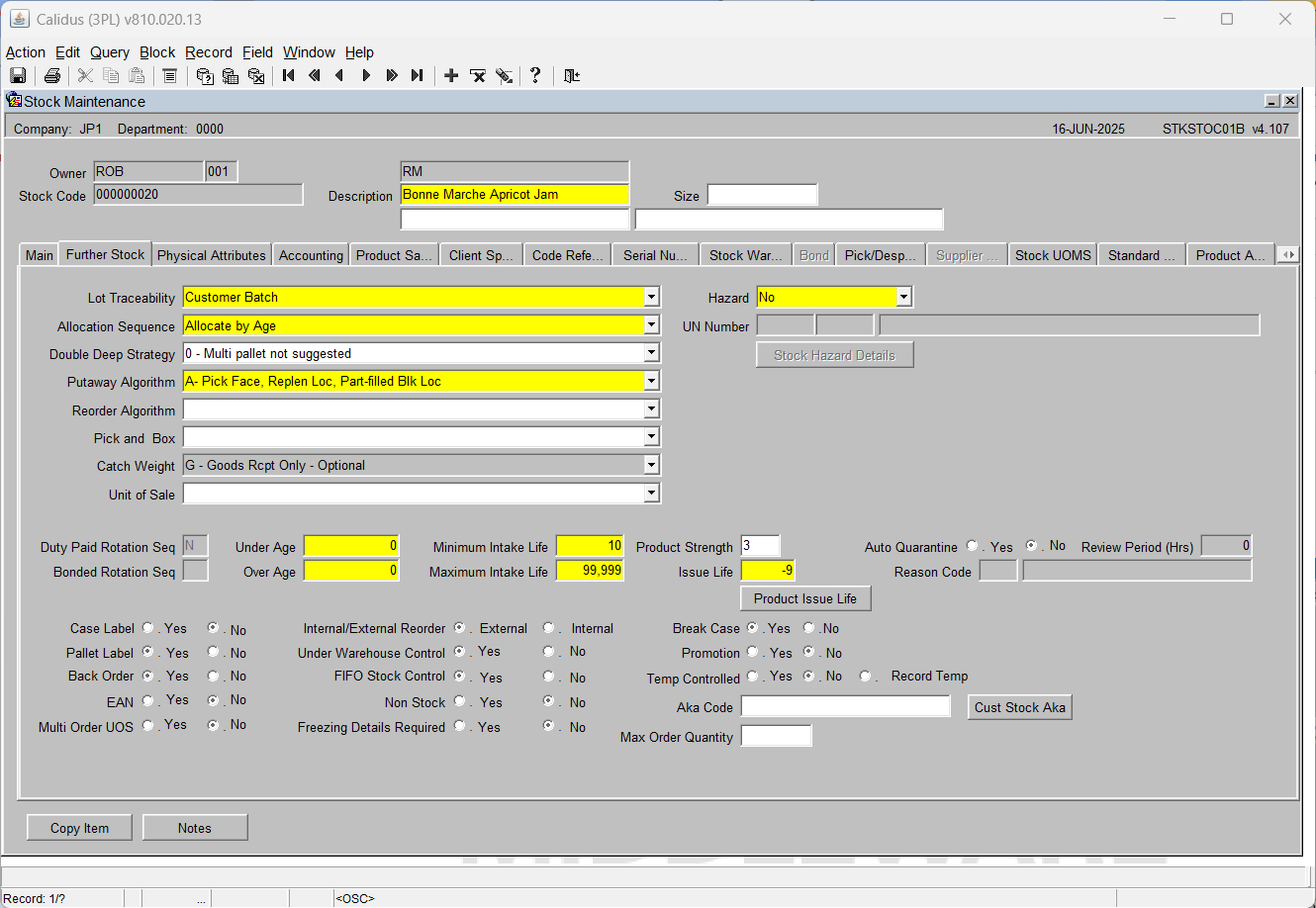
| Field Name | Description | Options | Generic Value |
| Lot Traceability ** | Determines what kind of rotation traceability you want for this product. This setting will prompt for this information at receipt |
D - Customer Batch | |
| Allocation Sequence ** | Allows the user to specify in what priority order allocation will take place for this product |
A - Allocate by Age | |
| Double Deep Strategy | Dicatates whether multi-deep functionality will be utilised and if so, in what priority |
0 - Multi pallet not suggested | |
| Putaway Algorithm ** | If auto putaway is to be utilised, determines which anchor point this product will use to start the putaway process. Note, there are 5 places to action autoputaway:- Owner Bulk Locations | ||
| Reorder Algorithm | Used for purchase order suggestion (not migrated) | 1 - Suppliers review days 2 - Daily replenishment Minm. | |
| Pick and Box | Client specific packing functionality (not migrated) |
C - One Case to a Box | |
| Catch Weight | Determines whether an ‘adhoc’ weight is to be captured at receipt or outbound – will override stock weight if set – also used for specific functionality |
C - Carton Wt. @ Rec/Pick | |
| Unit of Sale | Denotes an additional unit of measure for the product other than the standard UOM’s created in stock maintenance (Main Tab.) Used mainly for reporting purposes (see ‘To transit’ for factorisation of unit to Impressions) |
A - Area | |
| Hazard ** | Dictates whether a product is hazardous or not. Setting this flag to anything other than ‘N’ will take you into an additional hazardous details screen |
N - No | |
| UN Number | Hazardous required UN number. Only allowed entry if hazardous flag is other than ‘N’ | 4 character plus single character UN variant – must be already created in hazard maintenance or left blank | Blank |
| Buttons | |||
| Stock Hazard Details | Allows the user to enter specific hazardous information for the product | ||
| Auto Quarantine ** | Determines whether a product will be automatically put on hold at receipt. If Y is selected, the user will be prompted for a reason code and a review period | Y or N | N |
| Reason Code | The reason code used for stock to be automatically put on hold | Must have been created in reason codes maintenance – LOV available | Defined by the client |
| Review Period (Hrs) | The number of hours before the hold is released | 0 –9999 | Defined by the client |
| Duty Paid Rotation seq | Taken from ware_last_numbers of type ROT – no setup required | ||
| Bonded Rotation Seq | Taken from ware_last_number of type ROT – no setup required | ||
| Under Age ** | The number of days the stock is in the warehouse before it is under age (not migrated) Used in allocation – the system determines if it is under age based on the age of the stock + under age days and if this is greater than current date | 0 – 999999999 (displays only 8 digits) will default to zero | Defined by the client |
| Over Age ** | The number of days the stock is in the warehouse before it is over age (not migrated) Used in allocation – the system determines if it is under age based on the age of the stock + over age days and if this is less than current date | 0 – 999999999 (displays only 8 digits) will default to zero | Defined by the client |
| Minimum Intake Life ** | If sell by dates are required, determines the minimum number of days the product must be in the warehouse. Allocation will use this flag in conjunction with max intake life and issue life to establish if it the product is outside the sell by date allowance | 0 – 99999 will default to zero | Defined by the client |
| Maximum Intake Life ** | If sell by dates are required, determines the maximum number of days the product can be in the warehouse. Allocation will use this flag in conjunction with min intake life and issue life to establish if it the product is outside the sell by date allowance | 0 – 99999 will default to zero. This must be greater than or equal to the minimum intake life | Defined by the client |
| Product Strength | The strength of the product if applicable (will print on the pick list when migrated) | 2 character free text field | Defined by the client |
| Issue Life ** | If sell by dates are required, determines the actual shelf life of the product. Allocation will use this flag in conjunction with max intake life and min intake life to establish if it the product is outside the sell by date allowance | 0 – 99999 will default to zero | Defined by the client |
| Case Label | Determines whether case labels are required for the product. Currently only generic case labels are available | Y or N – will default to N | N |
| Pallet Label | Determines whether pallet labels are required for the product. Currently only generic and Schenker specific pallet labels are available | Y or N – will default to N | N |
| Back Order | Used in conjunction with product class and other flags, indicates whether this product can be back ordered | Y or N – will default to N | N |
| EAN | Indicates whether an EAN number is required | Y or N – will default to N | N |
| Multi Order UOS | Allows the user to enter an additional unit of sale at order entry if required | Y or N – will default to N | N |
| Internal/External Reorder | Used for automatic purchase ordering (not migrated) | E or I – will default to E | E |
| Under Warehouse Control ** | Specifies whether the product is under full warehouse control (not migrated) | Y or N | Y |
| FIFO Stock Control ** | Will determine at autoputaway whether FIFO will be considered | Y or N | Defined by the client |
| Non Stock ** | Specifies whether the product will actually be stored and monitored as a normal stock item or classed as a ‘not in stock’ i.e. not to be processed product | Y or N | N |
| Freezing Details Required ** | Determines, if product is to be frozen whether an additional box for freeze details will appear at receipt to capture date/ place frozen. | Y or N | N |
| Break Case ** | If a product is to be processed in both cases and units, specifies whether cases can be broken into units for this product in order to fulfil ordered unit qtys where no units are available at time of allocation. | Y or N | N |
| Promotion ** | Is this a promotional material? | Y or N | N |
| Temp Controlled ** | Specifies whether the product is temperature controlled. This will determine whether special processing throughout the system will be required | Y or N | N |
| Record Temp | If this flag is checked, the temperature recorded at receipt will be held on the system | Checked or left blank | Blank |
| Aka Code | An additional ‘also known as’ field to allow an alternative product code to be used | 20 character free text field or left blank | Blank |
Stock Maintenance – Physical Attributes Tab
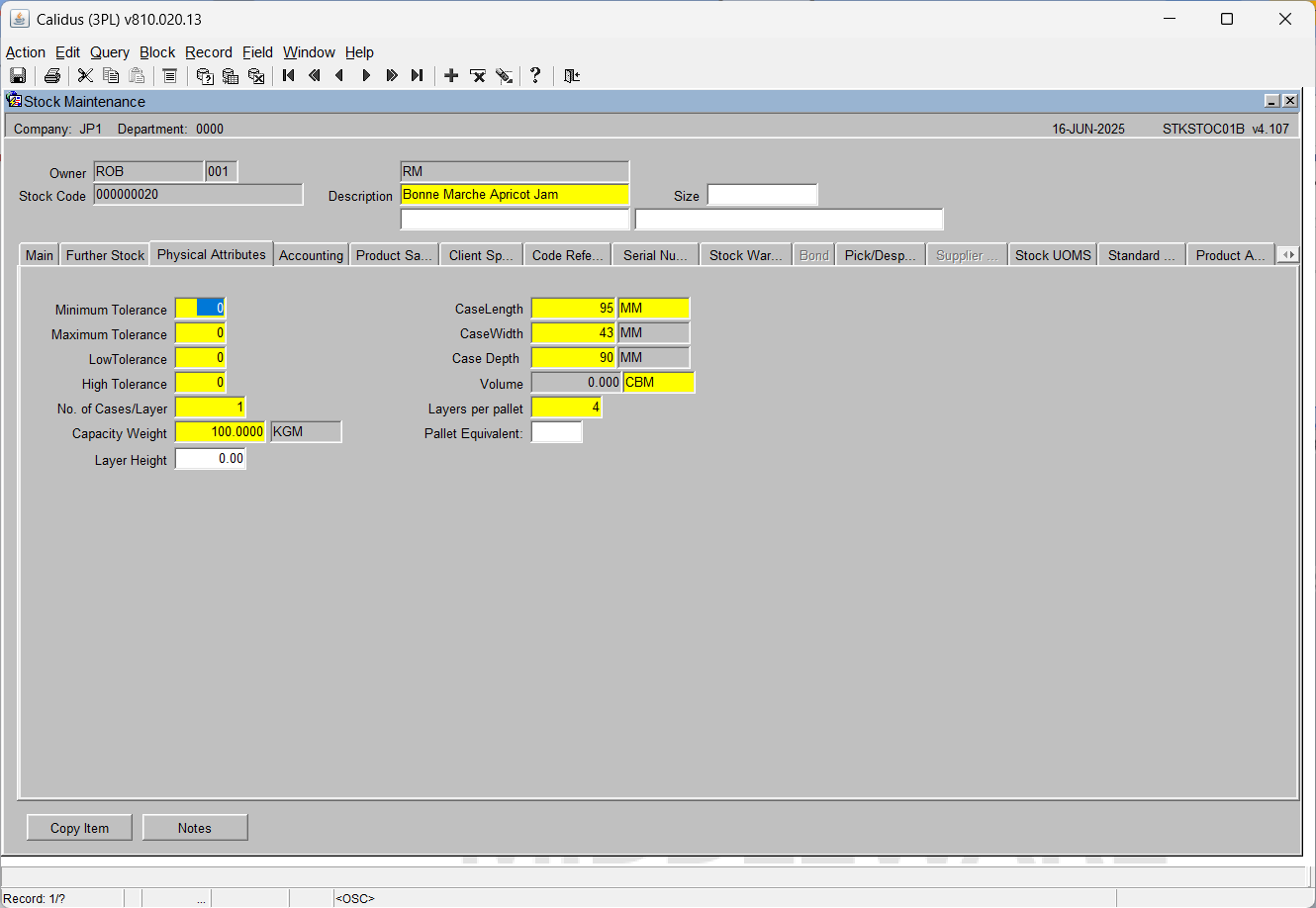
Stock Maintenance – Accounting Tab
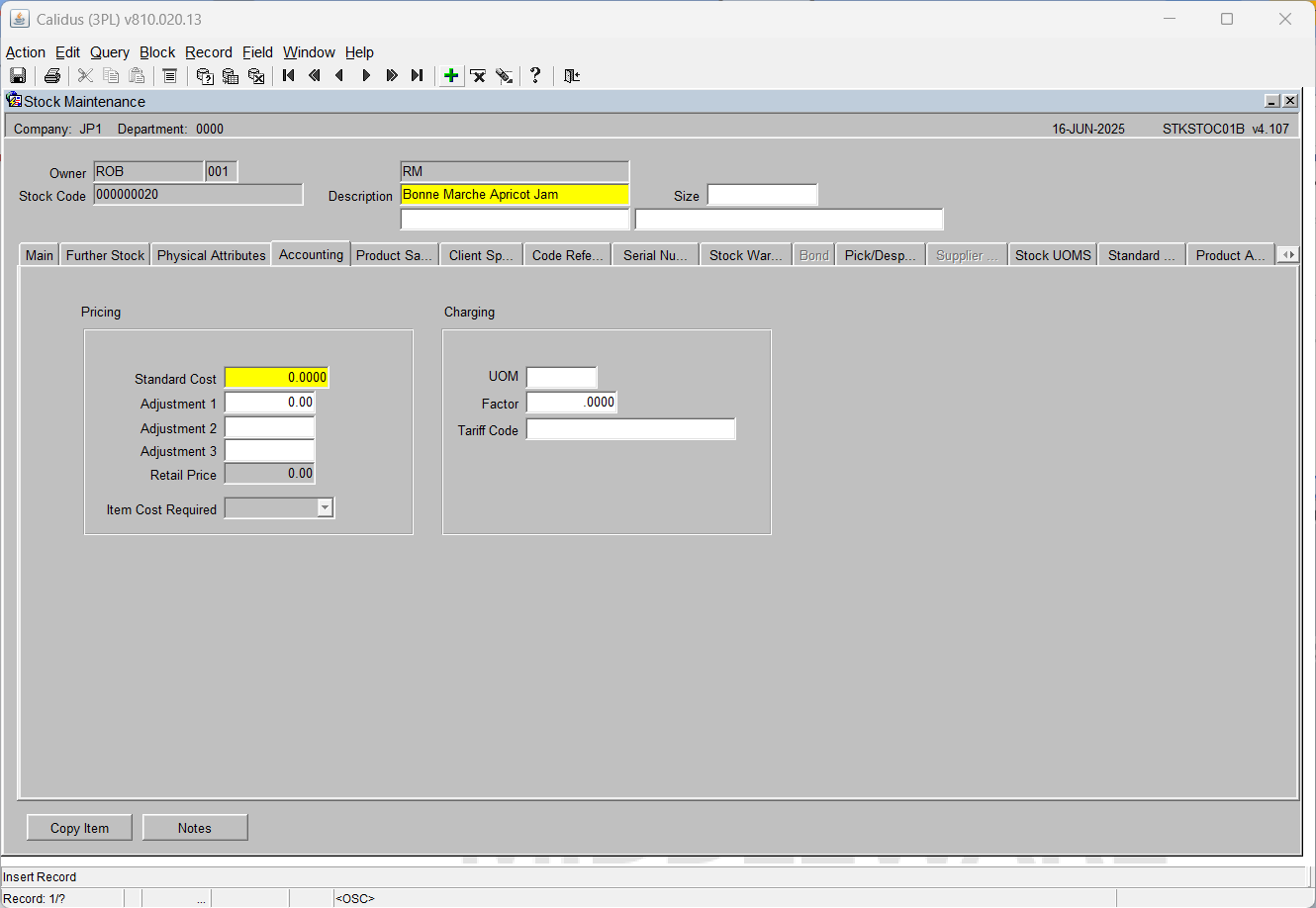
Stock Maintenance – Product Sampling Tab
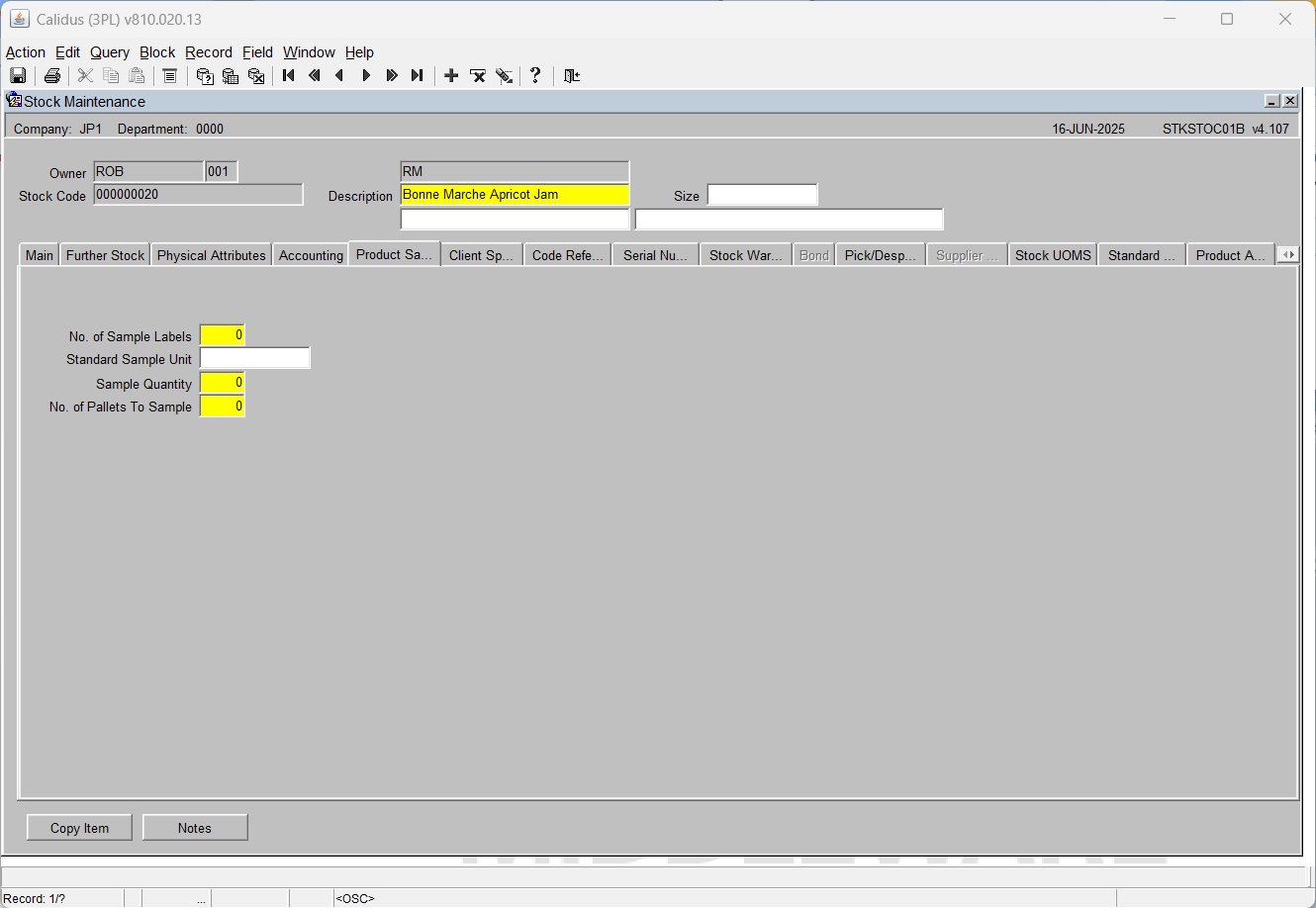
Stock Maintenance – Client Specific Tab
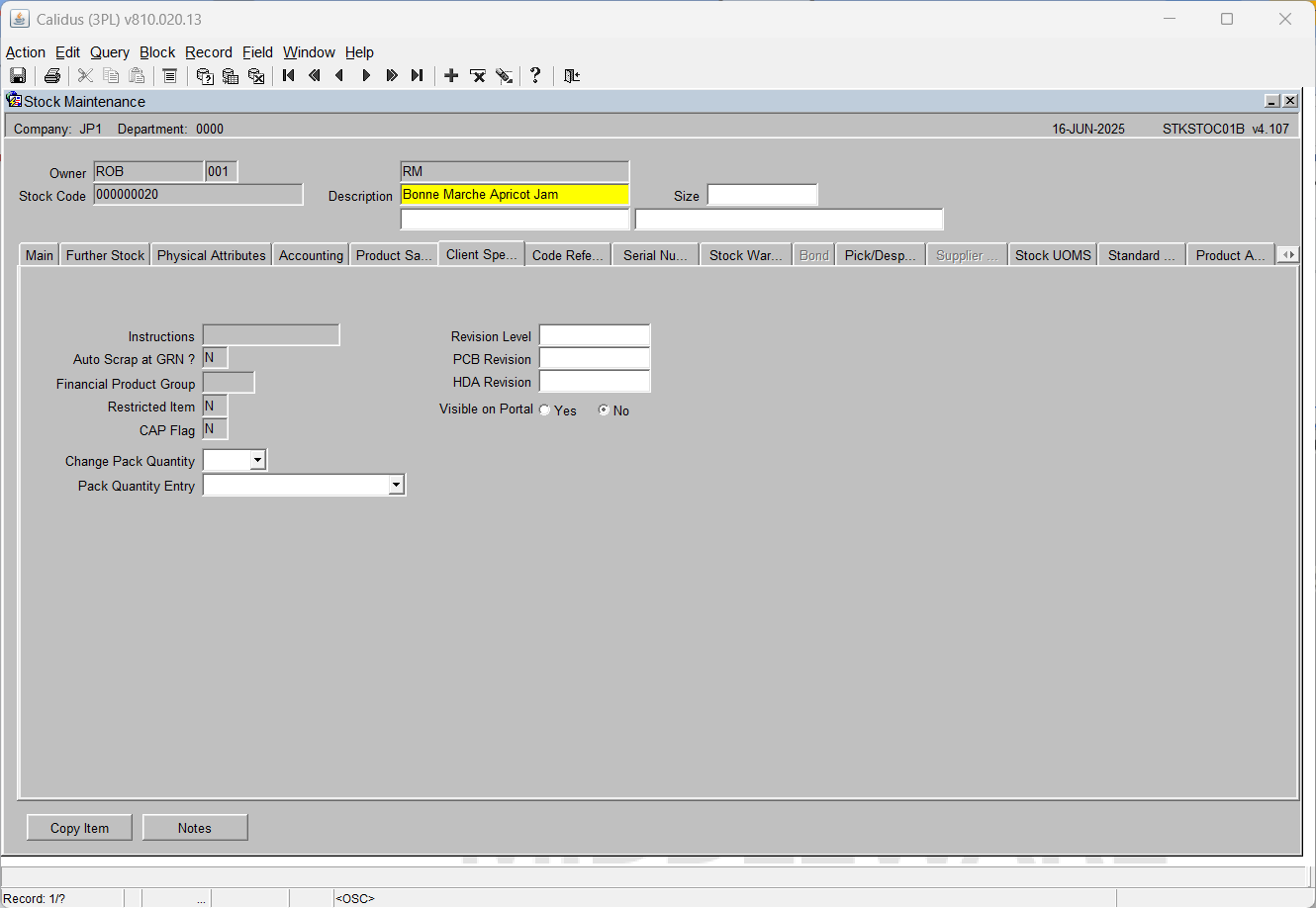
Stock Maintenance – Code References Tab
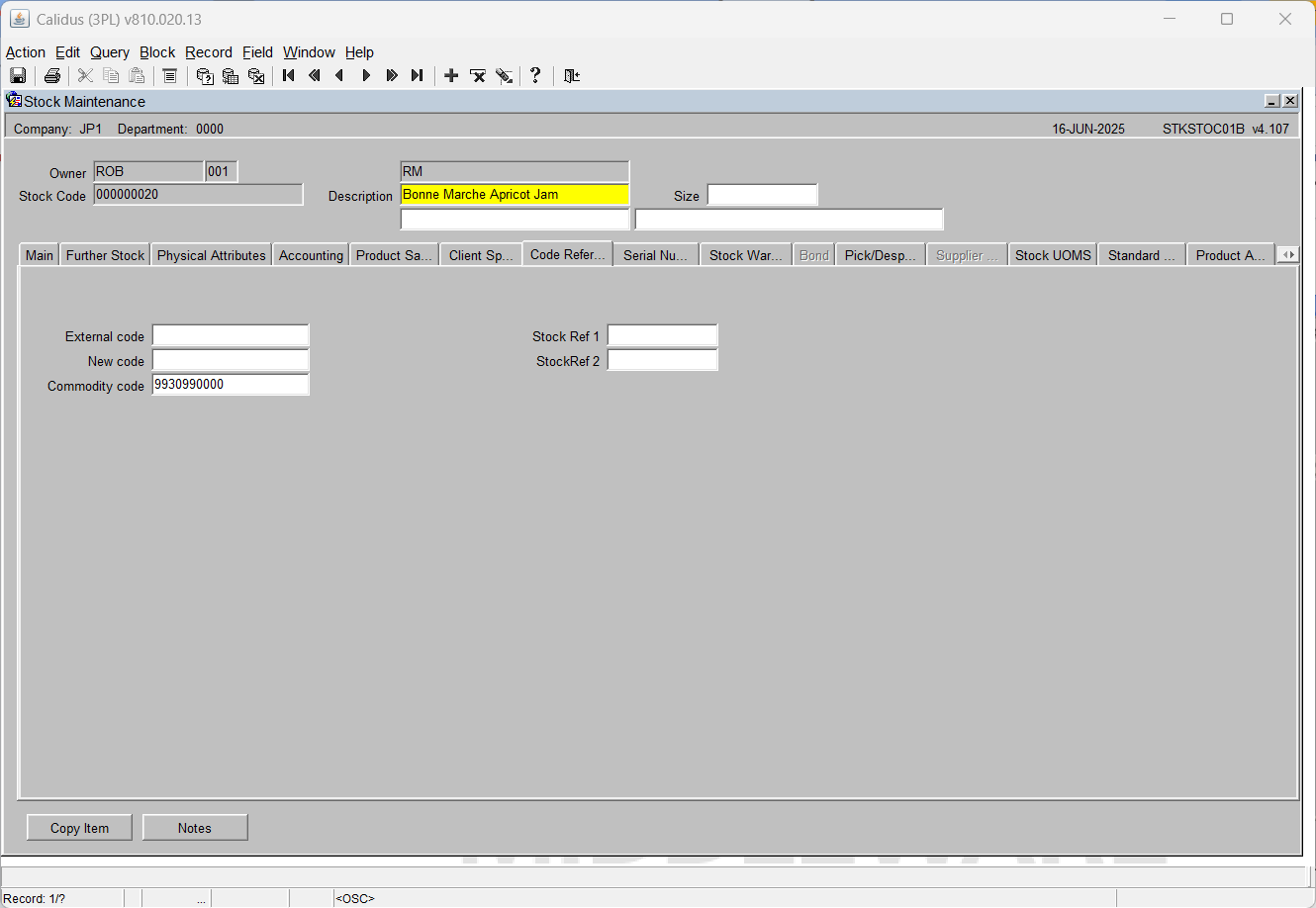
Stock Maintenance – Serial Numbering Tab
This tab screen enables the configuration of a product to enable the capture of serial number details at a carton level at either the inbound or outbound stages
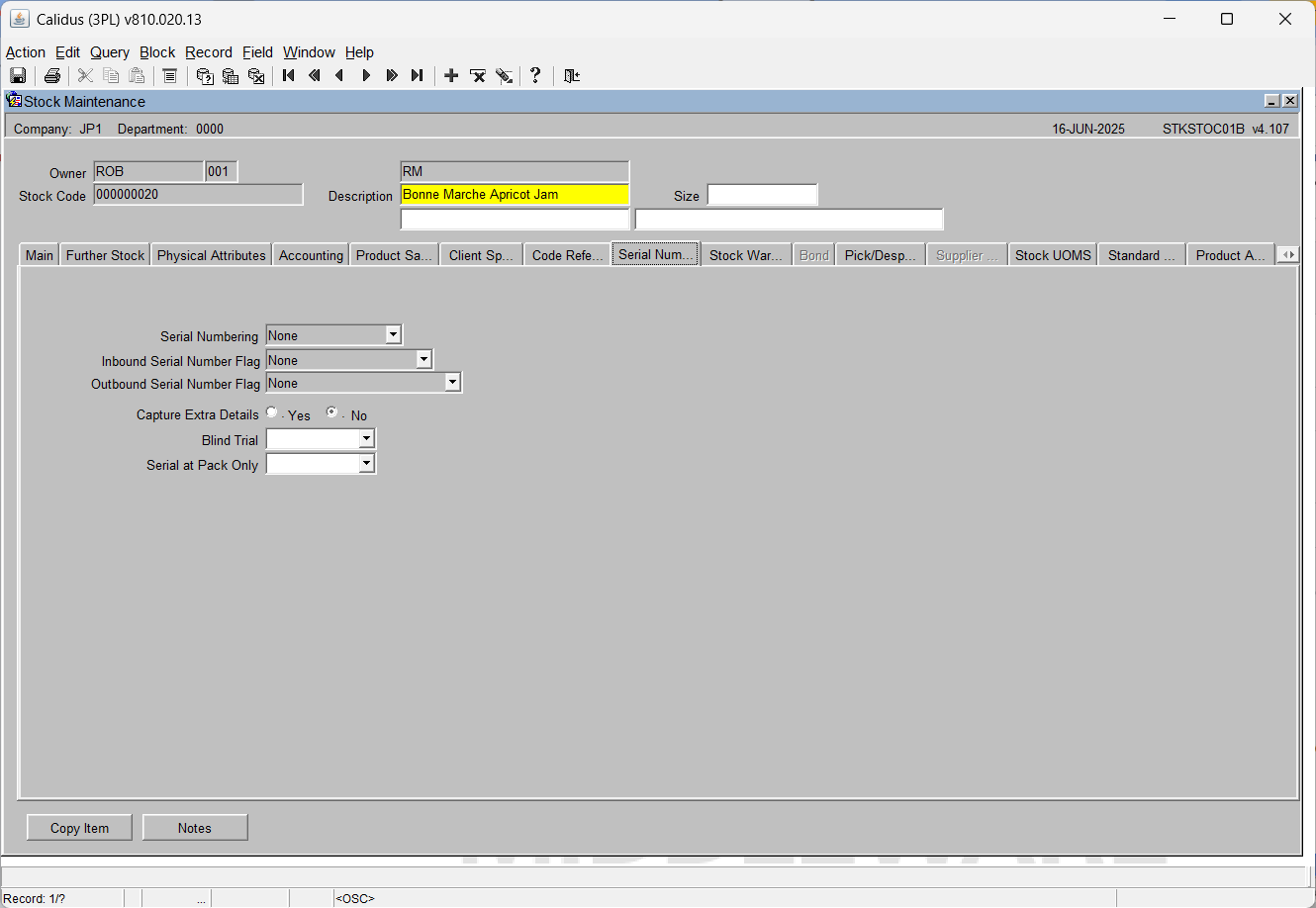
Stock Maintenance – Stock Warehouse Tab
This tab screen provides configuration control for a product’s warehouse level settings. Note that there can be multiple records for a given product in cases where the product is stored in multiple warehouses.
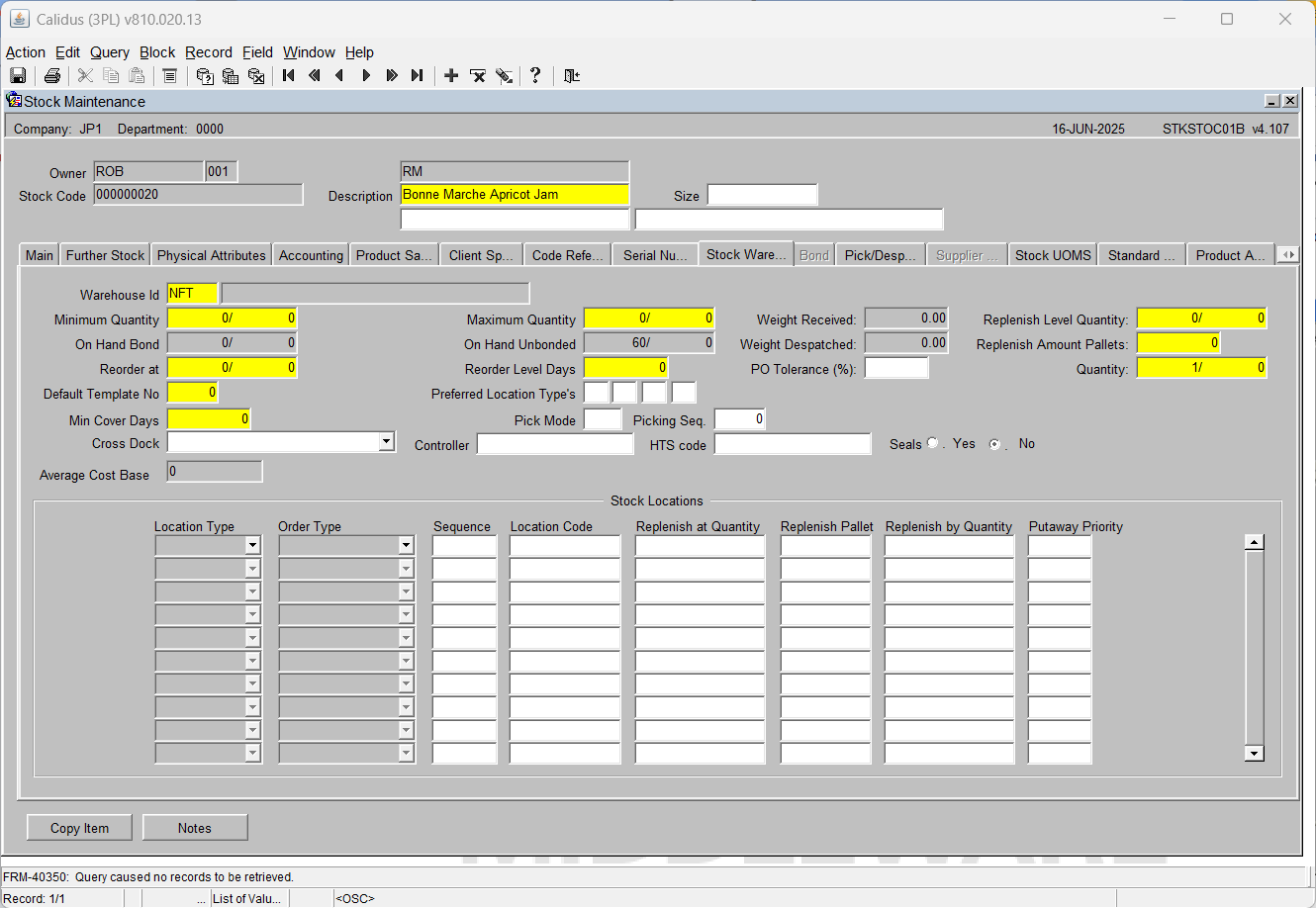
Unbonded Stock Locations Details
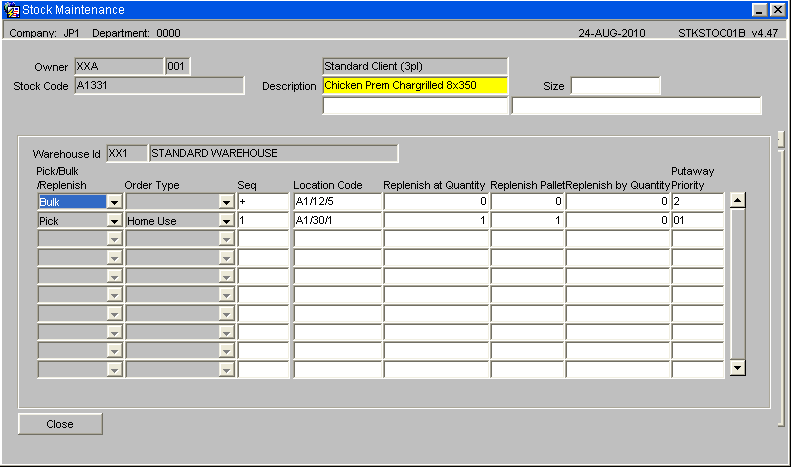
Stock Maintenance – Pick/Despatch Messages (Not Migrated)
This tab screen enables the configuration of product level message lines that can be configured for individual customers for reporting purposes, namely on despatch notes and pick lists.
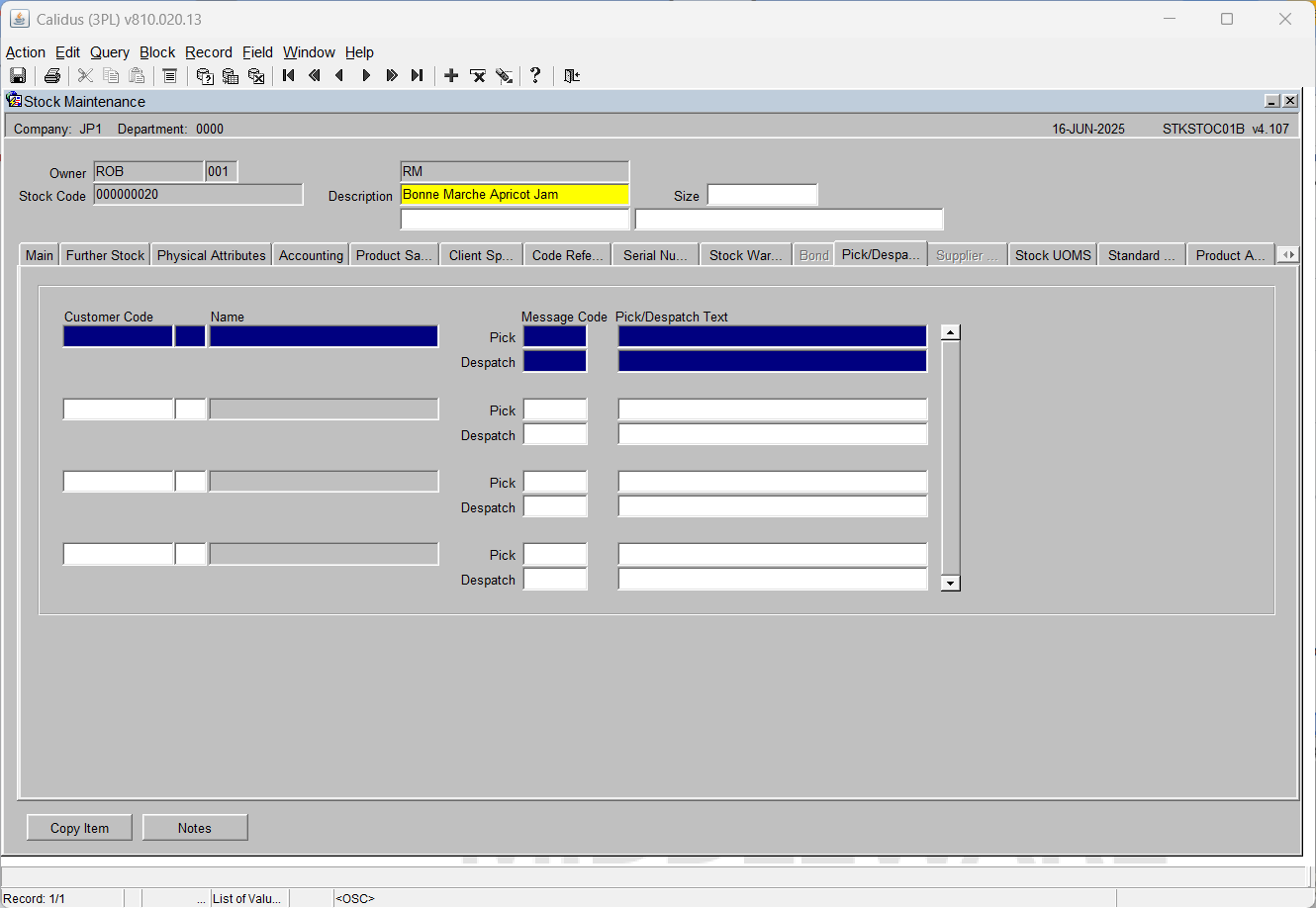
Stock Maintenance – Stock UOMS Tab (Not Migrated)

Stock Maintenance – Standard Pallets Tab
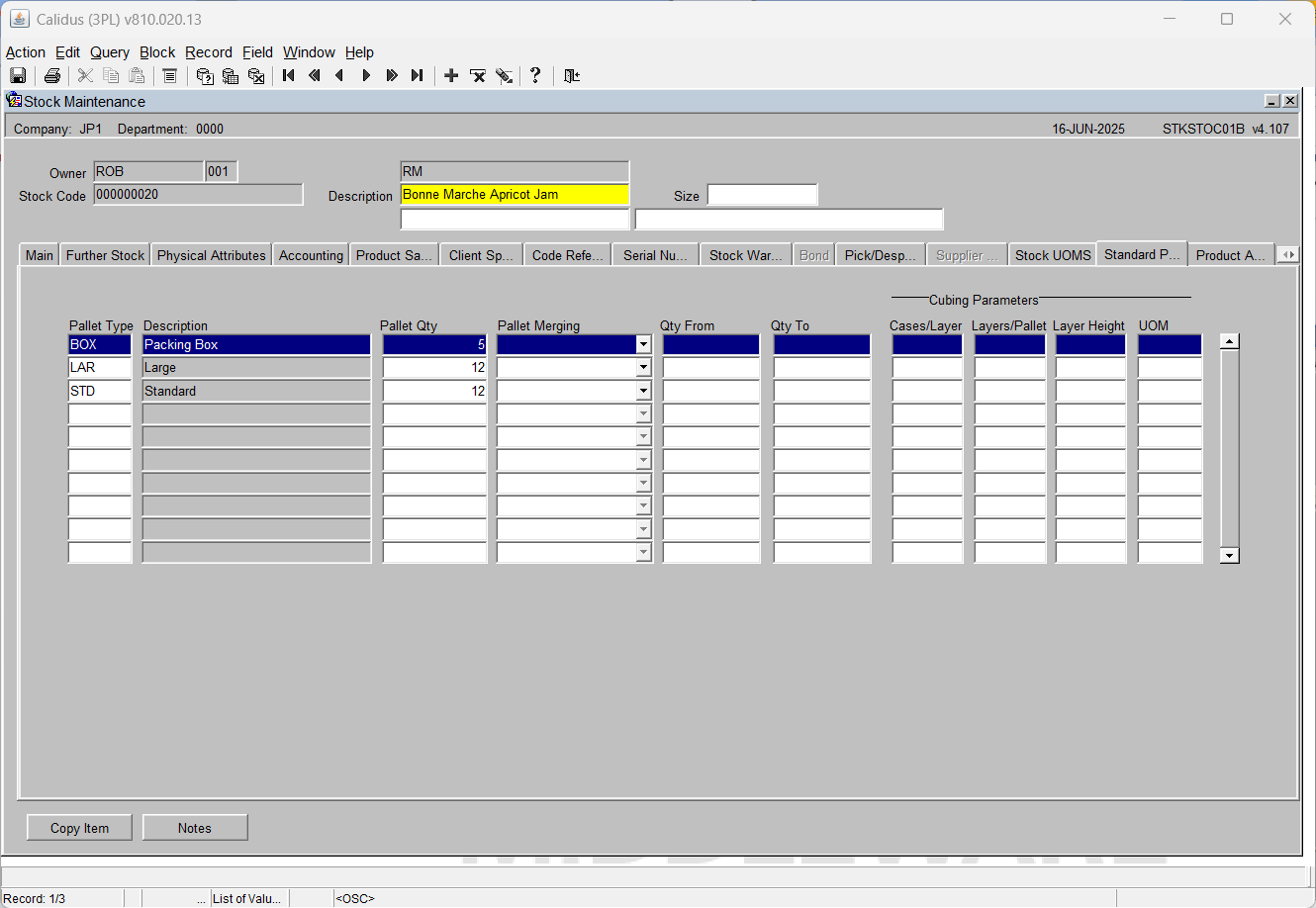
Stock Maintenance – Product Analysis Tab (Not Migrated)
This screen is used to assign analysis types to a particular product. Once assigned, this analysis type can be used to group products together and assign values to them.
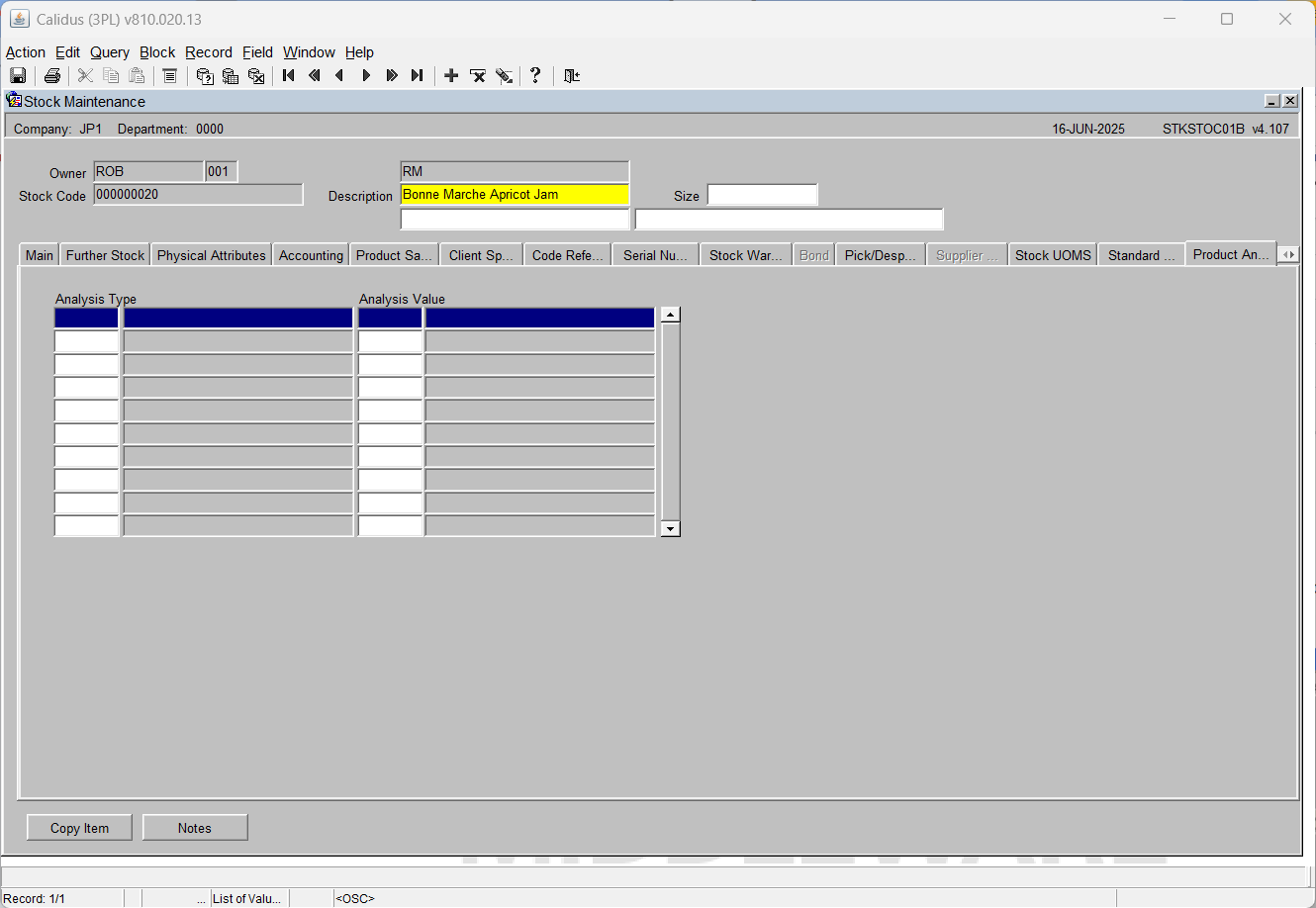
Stock Maintenance – Order UOS Tab
You are only allowed entry into this tab if you have the ‘Multi Order UOS’ box checked to Y in the Further Stock Tab. Facilitates ordering in multiple units of measure for conversion into case/unit quantities for allocation and picking.
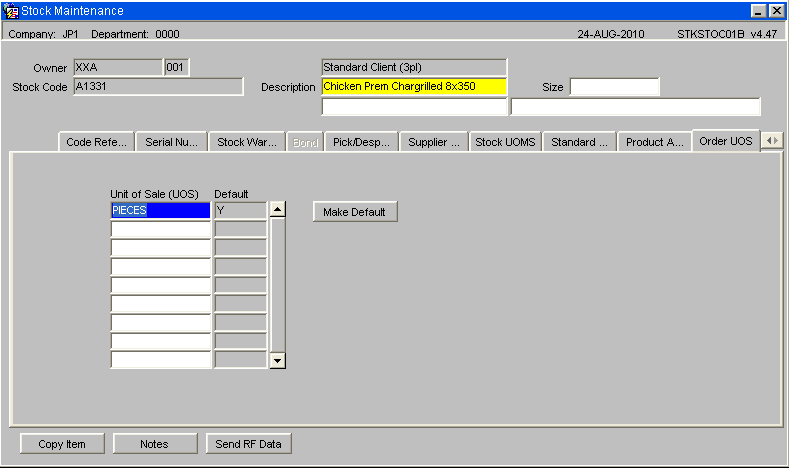
7. SUBSTITUTE STOCK MAINTENANCE
Allows the user to assign different product codes to this product in various priority order. If an order is raised for the main product and there is no stock, the system will automatically search for stock within its substitute products and if available, will allocate these instead of the main product.